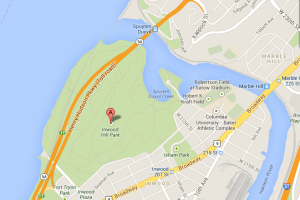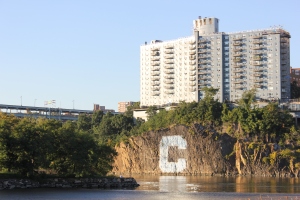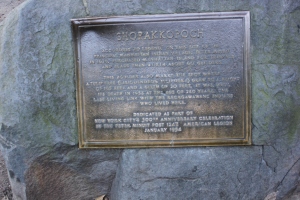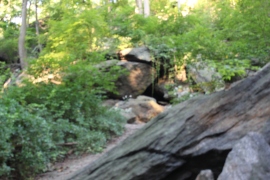Exploring Inwood Hill Park: The Last Remnant of Mannahatta
I’ve lived in and around New York City my entire life and yet, I never stop marveling at certain aspects of it. I love the old cliché of eight million stories, each one fascinating and unique. People make a city of course and the cosmopolis that is New York is no different. However, in New York, sometimes the geography and the literal lay out of the city are ignored. Sure, you can’t help but be captivated by the skyscraper canyons that form in perfect grid in Manhattan, or the glorious park at its center, providing a clean break from the iron and concrete structured functionality of a New York minute. Just like the buildings and Central Park, most of the stuff this city is admired for was made by the hands and thoughts of humans. In fact, one can consider New York City as a whole to be a monument to( for better or worse) persistent human progress.
However, how many people imagine what Manhattan Island might have been like before it took its current form? What was New York like before the steel, and the sidewalks? What was it like before the subway, before the hills on the island were leveled? What was it like even before regular inhabitants? Lucky for us, the folks of the Wildlife Conservation Society thought intensive efforts have mapped out much of New York City as it looked in 1609. They call their project Welikia, after the Lenape word for “my good home.” They have based their research on both American Indian and European accounts of the area and have created a nifty 3D rendering of what many New York neighborhoods looked like at the beginning of the 17th century. All that and more can be found at http://welikia.org/. A quick glance at their map reveals that Manhattan Island was once home to dense forests, hills, meadows, swamps and an abundance of wildlife. This of course is a sharp contrast to the island today.
If you are a New Yorker who happens to be feeling the transcendental spirit, fear not. Though most of Manhattan resembles a world far removed from that of 1609, a ride on the A train uptown to its terminus at 207th street in Inwood might as well be your time machine to the Manhattan of the Lenape and early Dutch settlers. Your destination, Inwood Hill Park, the last remaining forest land on Manhattan Island. That’s right, Inwood Hill Park is the only place where you can visit a Manhattan of yesterday, today.
I don’t live far from Inwood Hill Park so I decided to venture there with a camera and do some urban exploring. Please join me on this photo tour.
I decided to enter the park on the Northeast corner at 218th street and Indian Road. The first thing I noticed was something far removed from the 1600’s. It was the light blue Columbia University C painted on a rock face in the Bronx. Columbia has its Baker Athletic Complex just east of the park and the Spuyten Duyvil Creek serves as the home to it’s rowing teams.
The creek creates a tidal marsh which sort of smells when you pass by, but than again, all great tidal marshes do. This is the last natural tidal basin in New York CIty. Visible is the Henry Hudson Bridge. Despite being named after someone from the 1600’s, its still obviously modern. So far at this point the park is a mix between natural wonders and any other New York City park with its ball fields and playgrounds.
I continue walking into the park and make a left behind a beat up soccer field. As I continue I notice something. It looks to be a rock with a small plaque on it. I figure it’s going to be something commemorating a donor from many years ago. When I finally get to the rock, I can’t believe my eyes. The plaque on the rock reads “Shorakkopoch: On This Site of the Principal Manhattan Indian Village, Peter Minuit, in 1626 purchased Manhattan Island for trinkets and beads then worth then worth about 60 guilders.” As a history nut, I am in heaven. The entire course of the modern history of this great city started at this very place. The plaque goes on to say that a tulip tree (the symbol of the Netherlands, the country which indirectly purchased the Island) stood at this spot for many years. My excitement quickly turns to sadness however as I realize that such an important place is essentially cast off and ignored. An essential cog in the history of New York and America pretty much neglected. Oh well. I am happy to have discovered it.
I continue on my journey into the woods. About fifteen paces as I enter, I look to my right. I was told that there were some American Indian Caves in the rocks here. They are hard to see at first but after a couple moments, they enter my vision. I walk up to explore them a little. They aren’t too big but they didn’t need to be. American Indian men and boys would come down from up river and make camp at this site in the summer. They used the land as a hunting and fishing retreat. To keep cool at night, they would sleep in these caves and wake up in the morning to begin another day of hunting and fishing. Sounds pretty good if you are into that. Who would have thought that there would be American Indian Caves on Manhattan island?
It’s here when I first feel a little isolated. Not too many people pass by and the only reminder that I’m still in New York City is the faint sound of bachata music I hear in the distance. The park is located in a neighborhood dominated by Dominican Americans and as it is the weekend, there are very few places you can go where you won’t hear some of the island tunes playing.
I walk further into the park. Now I am alone. The sound of the bachata music is gone. I can hear a faint rush of cars from the nearby Henry Hudson parkway. The quiet doesn’t compare to the quiet found in the countryside, but for Manhattan it feels somewhat eerie.
The trail starts to get hilly. I get a little winded. I slip on a rock and almost twist my ankle. “Bad day to wear boat shoes.” I say to myself. I should have assumed there would be hilly topography considering the word Hill is in the name of the park, but sometimes I tend to skip over those sort of details. It’s crazy to think that most of Manhattan used to be just as hilly as this. Way uptown where I am, there are lots of hills and that’s because it was the last area to be developed on the island. For most of Manhattan, they leveled the hills to make way for the grid. Here they gave up. And thank God for that although I’m not so thankful at the moment.
The park was once home to many grand county estates. Yes, at one point this was the country. New Yorkers would come uptown to spend the weekend as if they were roughing it. Much of this land was owned by Isidor Straus, one of the co-owners of Macy’s who famously perished on the Titanic. Through my research I also found out that there was an orphanage somewhere located in these woods. However there are no signs of buildings today and most of them were leveled in the thirties as a WPA project when the city purchased the land for park conversion. There are still some remnants of foundations however if you look hard enough.
I pass some large boulders. There are grooves and nicks in them similar to those found in Central Park. The boulders in Central Park are about the only thing that wasn’t planned by humans there but here they are in their native habitat. These rocks have been here for thousands of years. The grooves in them are from when the glaciers pulled away and melted after the last ice age. Touching them feels like I am going back to prehistoric times.
Finally after feeling lost for a half an hour or so, I find stairs leading downhill to an exit on the other side of the park. As I leave the park, I’m still amazed that all of this was not too far from where I live but yet worlds away. This is what Henry Hudson saw when he sailed up the river which would later bear his name. It was a lush untouched paradise full of potential and danger. I wonder if he had any sort of vision for what Manhattan could be. I love this city but in all its glory, sometimes the nature and isolation that used to exist here is so far removed, it’s hard to imagine it ever existed at all.
All in all though, I still like for the most part what this city has become. It reminds me of a poem by New Yorker Walt Whitman entitled Mannahatta, which was the American Indian name for Manhattan. I will leave you today with that poem. Hope you enjoyed reading this post and thanks for letting me share my urban adventure with you. Don’t forget to like this post on facebook, follow me on twitter, go back and read all my other posts and please please comment. Thanks.
-Clash out.
#ClashMcCoy, #InwoodHillPark, #NewYorkCity
maps courtesy of google.
Mannahatta by Walt Whitman
I was asking for something specific and perfect for my city,
Whereupon lo! upsprang the aboriginal name.
Now I see what there is in a name, a word, liquid, sane, unruly,
musical, self-sufficient,
I see that the word of my city is that word from of old,
Because I see that word nested in nests of water-bays, superb,
Rich, hemm’d thick all around with sailships and steamships, an
island sixteen miles long, solid-founded,
Numberless crowded streets, high growths of iron, slender, strong,
light, splendidly uprising toward clear skies,
Tides swift and ample, well-loved by me, toward sundown,
The flowing sea-currents, the little islands, larger adjoining
islands, the heights, the villas,
The countless masts, the white shore-steamers, the lighters, the
ferry-boats, the black sea-steamers well-model’d,
The down-town streets, the jobbers’ houses of business, the houses
of business of the ship-merchants and money-brokers, the
river-streets,
Immigrants arriving, fifteen or twenty thousand in a week,
The carts hauling goods, the manly race of drivers of horses, the
brown-faced sailors,
The summer air, the bright sun shining, and the sailing clouds aloft,
The winter snows, the sleigh-bells, the broken ice in the river,
passing along up or down with the flood-tide or ebb-tide,
The mechanics of the city, the masters, well-form’d,
beautiful-faced, looking you straight in the eyes,
Trottoirs throng’d, vehicles, Broadway, the women, the shops and shows,
A million people–manners free and superb–open voices–hospitality–
the most courageous and friendly young men,
City of hurried and sparkling waters! city of spires and masts!
City nested in bays! my city!

















Excellent post. You always do a marvelous job painting a picture with your words.
Thanks for stopping by!